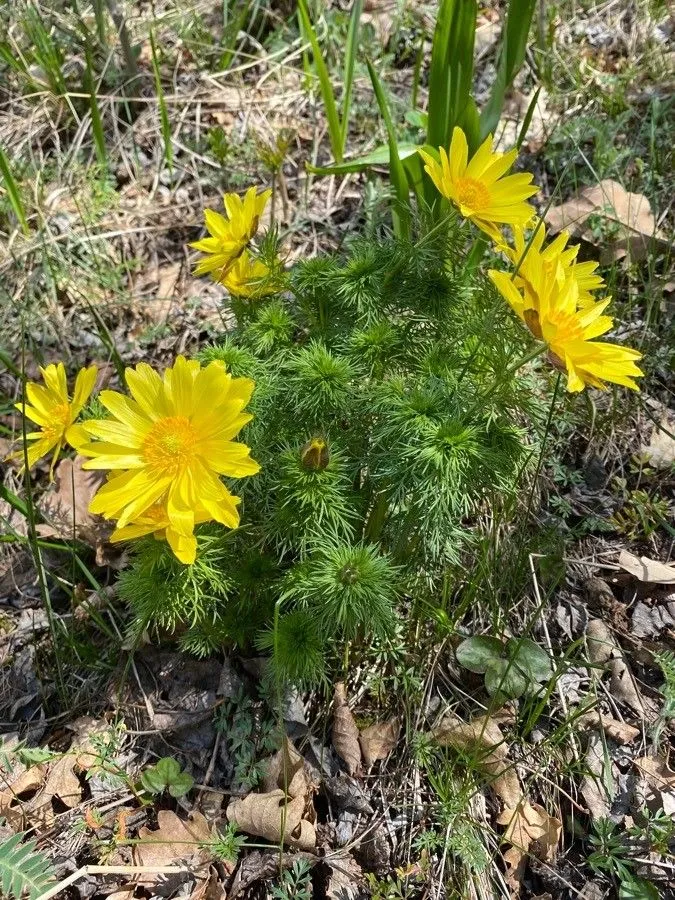
Author: L.
Bibliography: Sp. Pl.: 547 (1753)
Year: 1753
Status: accepted
Rank: species
Genus: Adonis
Vegetable: False
Observations: Europe to Siberia and Caucasus
Spring adonis is a remarkable and vibrant flowering plant known for its striking appearance and its important place in botanical studies. Bearing the scientific name Adonis vernalis, this perennial herb is a proud member of the Ranunculaceae family, a group renowned for its diversity and ornamental value.
The plant is indigenous to a wide geographic range, stretching from Europe to Siberia and the Caucasus. This expansive distribution is a testament to its adaptability and resilience, thriving in various climates and terrains across these regions. The natural habitats of Spring adonis often include grasslands, steppes, and sunny slopes, where it can bask in ample sunlight.
Noted for its bright golden-yellow blossoms, Spring adonis heralds the arrival of spring with its vivid flowers, which usually bloom from April to May. Each flower, consisting of numerous delicate petals, evokes a sense of warmth and renewal after the cold winter months. These prominent and radiant flowers are not just visually appealing; they also play a vital role in attracting pollinators such as bees, which are essential for the plant’s reproductive cycle.
Adonis vernalis was meticulously documented by the esteemed botanist Carl Linnaeus in his seminal work “Species Plantarum” in 1753, where its detailed description can be found on page 547. Linnaeus’s classification has provided a robust foundation for further botanical research and understanding of this species.
Moreover, Spring adonis is well known for its historical and cultural significance. Traditionally, parts of the plant have been used in herbal medicine, attributed with various therapeutic properties. However, it is important to note that like many members of the Ranunculaceae family, Adonis vernalis contains potent compounds that can be toxic if not used properly, underscoring the need for careful and knowledgeable application.
In the landscape of natural beauty and botanical importance, Spring adonis stands out not only for its aesthetic charm and ecological role but also for its rich history and contributions to botanical science. Whether found in a wild meadow or carefully cultivated in a garden, this plant continues to captivate and inspire those who encounter it.
Deu: frühlings-adonisröschen, frühlingsadonis
Eng: spring pheasant’s eye, oxeye, pheasant’s-eye, spring adonis, yellow pheasants-eye
Fra: adonis du printemps
Nld: voorjaarsadonis
Swe: våradonis, arontorpsros
Nno: våradonis
Nob: våradonis
En: Spring adonis, Pheasant’s-eye, Oxeye, Spring pheasant’s eye, False hellebore, Pheasant’s eye, Yellow pheasant’s eye, Yellow pheasants-eye, Spring Pheasant’s-eye Adonis, Yellow Adonis, Ox-eye, Spring Pheasant’s-eye, Yellow Pheasant’s-eye
Sq: Adonida
Ar: أدونيس ربيعي
Az: Bahar xoruzgülü
Ba: Һары умырзая
Eu: Udaberriko adonis
Be: Жаўтацвет вясенні
Bg: Пролетен гороцвет
Ca: Adonis de primavera, Adonis vernal
Ce: БӀаьстенан маьлхабӀаьрг
Zh: 春侧金盏花, 春側金盞花, 春福壽草, 春福寿草
Cv: Ăншăрт курăкĕ
Cs: Hlaváček jarní
Da: Vår-Adonis
Nl: Voorjaarsadonis
Et: Kevadadoonis
Fi: Kevätruusuleinikki, Kevätruusu leinikki
Fr: Adonis du printemps, Adonis de printemps, Adonis printanier, Adonide du printemps, Adonis printanière, Faux Ellébore noir, Faux Hellébore noir, Grand Oeil-de-boeuf, Oeil-du-Diable
De: Frühlings-Adonis, Frühlings-Adonisröschen, Frühlingsadonis, Frühlingsadonisröschen, Frühlingsteufelsauge, Teufelsauge, Böhmisches Christwurzkraut, Frühlings-Teufelsauge
Hu: Tavaszi hérics
It: Adonide gialla, Adonide primaverile
Kk: Köktem janargüli, Көктем жанаргүлі, كوكتەم جانارگۇلى
Lt: Pavasarinis adonis
Lb: Däiwelsa
Mk: Пролетен гороцвет
No: Våradonis
Nb: Våradonis
Nn: Våradonis
Os: Æндæдзаг кæрдæг
Fa: چشم قرقاول
Pl: Miłek wiosenny
Ro: Rușcuță de primăvară, Ruscuta primavaratica
Ru: Goritsvet vecennij, Adonanthe vernalis, Adoniastrum vernale, Adonis dahurica, Adonis helleborus, Adonis parviflora, Adonis pratensis, Anemone consiligo, Chrysocyathus vernalis, Адонис весенний, Горицвет весенний, Стародубка, Черная трава, Черногорка
Sr: Adonidis vernalis herba, Adonis apenina, Adonis helleborus, Гороцвет
Sk: Hlaváčik jarný
Es: Adonis vernal, Adonis de primavera, Eléboro falso con flor de buftalmo, Flor de Adonis, Ojo de perdiz, Sello de oro, Yerba de Adonis
Sv: Våradonis, Arontorpsros, Varadonis
Zh-tw: 春側金盞花
Tt: Язгы утчәчәк
Zh-hant: 春側金盞花
Uk: Горицвіт весняний
© copyright of the Board of Trustees of the Royal Botanic Gardens, Kew.
© copyright of the Board of Trustees of the Royal Botanic Gardens, Kew.
© copyright of the Board of Trustees of the Royal Botanic Gardens, Kew.
Taken Apr 27, 2021 by Jacques Zuber (cc-by-sa)
Taken Apr 27, 2021 by Jacques Zuber (cc-by-sa)
Taken Apr 12, 2022 by Kiko (cc-by-sa)
Taken May 3, 2016 by Jacques Zuber (cc-by-sa)
Taken Apr 27, 2021 by Jacques Zuber (cc-by-sa)
Taken Apr 18, 2019 by Emanuele Santarelli (cc-by-sa)
Taken Mar 6, 2021 by Lejarazu Edorta (cc-by-sa)
Taken Apr 27, 2021 by Jacques Zuber (cc-by-sa)
Taken Apr 9, 2017 by Philippe Feldmann (cc-by-sa)
Taken Apr 27, 2021 by Jacques Zuber (cc-by-sa)
Taken Apr 9, 2017 by Philippe Feldmann (cc-by-sa)
Taken Apr 1, 2020 by defayes manuela (cc-by-sa)
Taken Apr 9, 2017 by Philippe Feldmann (cc-by-sa)
Taken Apr 27, 2021 by Jacques Zuber (cc-by-sa)
Taken Jul 17, 2021 by ann livie (cc-by-sa)
Taken Mar 31, 2020 by danielle berclaz (cc-by-sa)
Taken Mar 22, 2014 by Bernadette Zinderstein (cc-by-sa)
Taken May 7, 2011 by EOL − Sarah Gregg (cc-by-nc-sa)
Taken Jun 18, 2014 by Tela Botanica − Pierre-Yves de Boissieu (cc-by-sa)
Taken Jun 3, 2014 by Tela Botanica − Geneviève Botti (cc-by-sa)
Taken May 14, 2019 by Kacirekova Barbora (cc-by-sa)
Taken May 9, 2022 by Llandrich anna (cc-by-sa)
Taken May 15, 2006 by Photoflora – Bernard TILLY (©)
Taken Jan 1, 1970 by Photoflora – L’Abbé COSTE (©)
Taken Mar 24, 2021 by huy HO (cc-by-sa)
Taken Feb 8, 2021 by Landschaftsgärtner (cc-by-sa)
Taken Apr 25, 2022 by Budia Chus (cc-by-sa)
Growth habit: Forb/herb
Bloom months: [‘apr’, ‘may’]
Family: Myrtaceae Author: (F.Muell.) K.D.Hill & L.A.S.Johnson Bibliography: Telopea 6: 402 (1995) Year: 1995 Status:…
Family: Rubiaceae Author: Pierre ex A.Froehner Bibliography: Notizbl. Bot. Gart. Berlin-Dahlem 1: 237 (1897) Year:…
Family: Sapindaceae Author: Koidz. Bibliography: J. Coll. Sci. Imp. Univ. Tokyo 32(1): 38 (1911) Year:…
Family: Asteraceae Author: A.Gray Bibliography: Pacif. Railr. Rep.: 107 (1857) Year: 1857 Status: accepted Rank:…
Family: Fabaceae Author: Medik. Bibliography: Vorles. Churpfälz. Phys.-Ökon. Ges. 2: 398 (1787) Year: 1787 Status:…
Family: Aspleniaceae Author: (Cav.) Alston Bibliography: Bull. Misc. Inform. Kew 1932: 309 (1932) Year: 1932…